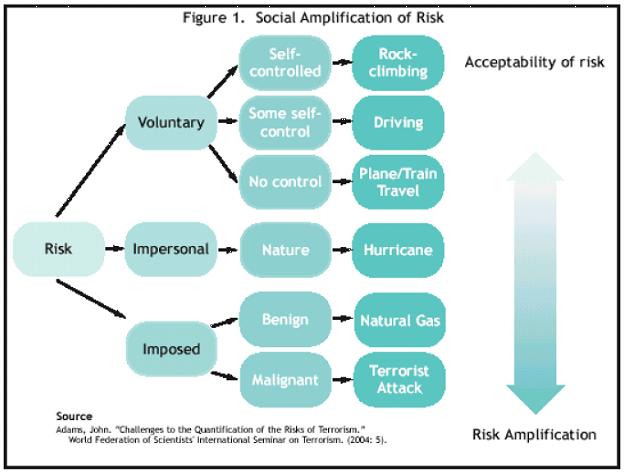6 million Jews died in the holocaust.
Every decade, 8 million people commit suicide.
So, we are experiencing the equivalent of an endless succession of holocausts occurring every decade.
In 2020, the US spent $1.6 billion on research to solve this problem through the National Institute of Mental Health.
In 2020, the US created $4000 billion and transferred it to the top 1% through the Federal Reserve’s Open Market Operations program.
Why is it acceptable to spend the equivalent of 2500 times more on corporate welfare than on research to try to stop an endless succession of holocausts by suicide?

If we need to stimulate the economy, why don’t we stimulate it by creating jobs through funding research into curing the diseases fueling these holocausts?
If we need to fund a bunch of wars, why don’t we fund a War on Mental Illness instead of pissing away $50 billion per year for decades on a failed Drug War that hasn’t even reduced the usage of dangerous drugs?

Or use a tiny fraction of the trillions spent on middle eastern wars that the public and internal Department of Defense investigations have enhanced terrorist recruitment efforts?

Your brain is dying.
After age 20, you lose about a gram of brain mass or 70 million brain cells every year! Multiply that by the 7.7 billion people in the world and it comes out to 54,000,000,000,000,000 brain cells lost every year. That’s a pretty big number! So to put that in perspective, just imagine one brain cell 54,000,000,000,000,000 times.
Fewer Brain Cells, Mo’ Problems
This natural brain rotting means we have 54 quadrillion fewer brain cells to solve problems like:
- Cancer, aids, cystic fibrosis, heart disease, and other chronic illnesses
- Climate change and the destruction of nature
- Wars and terrorism
- Poverty, starvation, and unemployment
- Government corruption
On top of the fact that your brain is naturally rotting, brain diseases also impose massive costs on the economy.
Insane in the Membrane
3 people will have killed themselves in the time it takes to read this article. (Hopefully, not as a result of reading this article.)
1 in 4 of your friends and loved ones are suffering from a mental illness like depression, bipolar disorder, or schizophrenia. It’s also expensive as hell. Here’s your bill for the year:
- Direct Medical Costs = $150 Billion
- Incarceration of the Mentally Ill = $35 Billion
- Social Services for the Mentally Ill = $150 Billion
- Lost Productivity and Absenteeism = $468 Billion
That all comes out to $803,346,862,554.63. Don’t forget to tip your server.
Also, I forgot to mention the 800,000 people that will commit suicide this year further reducing our global problem-solving brain cell pool by 80,000,000,000,000,000 brain cells.
Alzheimer’s Disease
Alzheimer’s disease is the leading cause of unsubstantiated claims that nurses are stealing your jewelry and trying to poison you.
The Magnitude of Alzheimer’s Disease
- 35.6 million people suffer from Alzheimer’s disease.
- Also, 35.6 million people suffer from Alzheimer’s disease.
- Also, have I ever told you about how 35.6 million people suffer from Alzheimer’s disease?
This 35.6 million will very likely include you or a parent or grandparent at some point.
The Financial Cost of Alzheimer’s Disease
$604 billion per year including:
- medical costs
- the cost of formal
- informal care
What are we doing to fix our broken brains?
So, as you can see, we’re spending trillions of dollars dealing with the consequences of our flawed or malfunctioning minds. One would think that we’re making similar efforts to prevent or find solutions to the root causes of these neurological failures.
Wrong!
Disproportionate Resource Allocation
This is just one of many examples of the reason why our neurological problems keep getting worse every year instead of better.
There’s a 1 in 20,000,000 chance you’ll be killed in a terrorist attack.
There’s a 1 in 10 chance you will die with Alzheimer’s disease.
However, we spend 162 times more on the military than brain research in order to prevent a threat that’s 2 million times less likely to affect you.
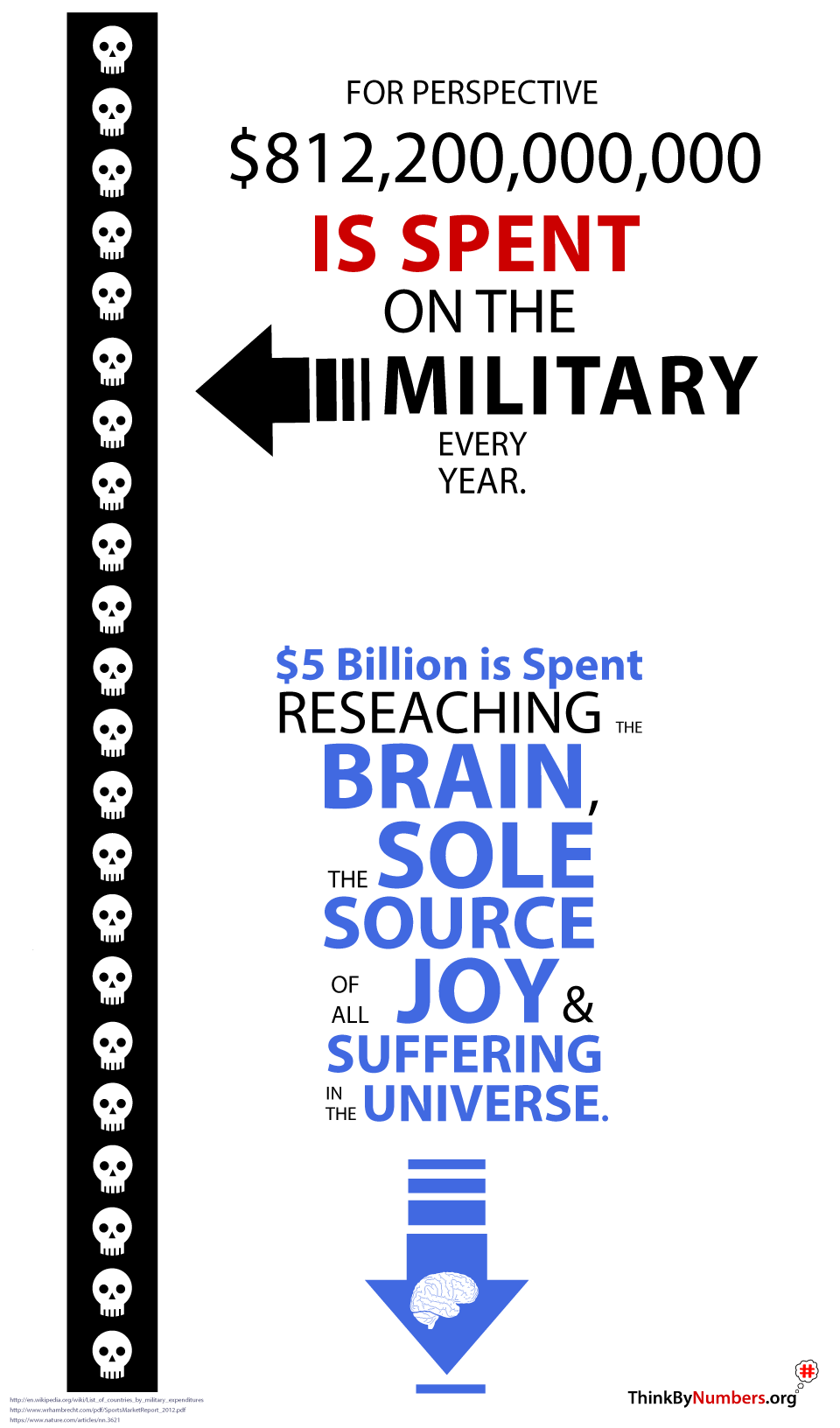
Another absurd fact is that we’ve spent as much on the F-35 Lightning II fighter jet ($1.7 trillion) worth 567 years of Alzheimer’s research ($0.003 trillion). And despite it’s name, the US Air Force has deemed a failure, partly due to the fact that it can’t fly in thunderstorms because nearby lighting damages the navigation systems.
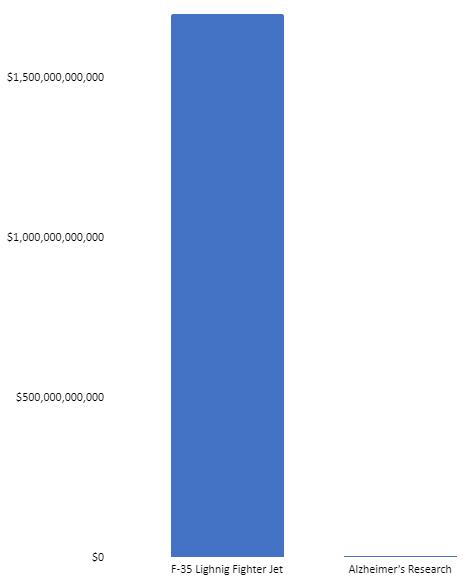
Indeed this disproportionate allocation of resources is the case for nearly every disease.
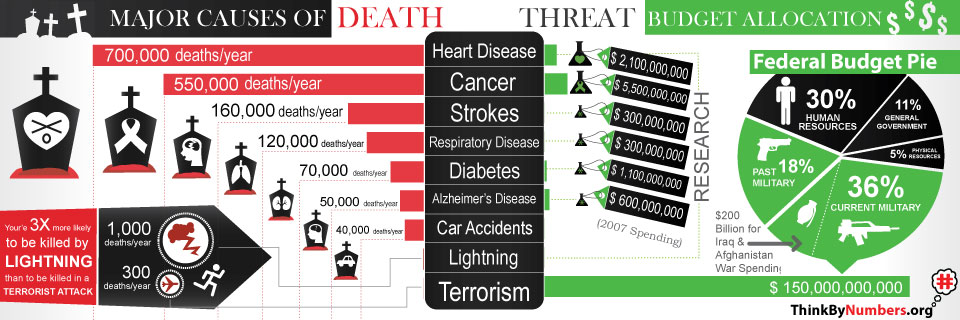
Insurance actuaries regularly perform complex risk analyses to determine the likelihood of death from various causes. Then they price life insurance rates to ensure that the rates are proportional to the likelihood of a payout. Large corporations do not have infinite resources to protect themselves from every possible threat to their business. So they have risk analyses divisions that allocate their limited resources in proportion to the likelihood of each threat. Like corporations, governments should utilize their resources in a manner that best protects and promotes the general welfare of their citizens. Unfortunately, the allocation of resources is instead primarily driven by lobbying efforts.
Obviously, a single death from terrorism is too many. However, we do not have infinite resources. We simply have to do a cost-benefit analysis and allocate our limited resources in proportion to the threat if we actually want to reduce suffering in the world.
Putting Terrorism in Perspective
Roughly 3,000 Americans have lost their lives to terrorist attacks in the last decade. This averages out to a loss of 300 people a year, which is a tragic figure and, as a country, it behooves us to do everything we can to reduce or eliminate the threat of terrorism. But there are still a lot of other ways to wind up being the main course at a worm banquet. The gravest dangers we face include heart disease, cancer, and celebrity breakups. Unfortunately, our country doesn’t have infinite resources available to eliminate every threat. So the task falls to our government to allocate what resources we do have in a manner proportional to the magnitude of each threat. If we, as a society, want to effectively counter the dangers we face, we first have to put them in perspective.
How You’re Really Going to Die
Ranked by the number of victims, heart disease comes in as the number one threat. It’s responsible for 700,000 deaths a year. This coronary malady keeps food on the tables of funeral directors nationwide. And, like a perpetual motion machine, this very food fills their arteries with cholesterol leading to even more heart attacks.
On to number two. Cancer kills 550,000 people a year. But ironically, some futurists see it as a potential key to immortality. It removes the limit on the number of times that a cell can replicate itself. Thus, if properly harnessed, this disease could be used to defy aging by allowing eternal tissue regeneration. This would enable Joan Rivers to continue enchanting Americans with her iconic brand of celebrity commentary for generations to come.
As previously stated, averaged over the last decade which contained the worst terrorist attack in our nation’s history, terrorism still only killed about 300 people a year. Compare this to the 1000 people who are struck by lightning every year. Hopefully, by putting storm clouds on the federal no-fly list we’ll be able to reduce this number in the future. But until then, based on current trends you’re three times more likely to be struck by lightning than to be killed in a terrorist attack.
| Risk | Annual Deaths | Lifetime risk |
| Heart disease | 652,486 | 1 in 5 |
| Cancer | 553,888 | 1 in 7 |
| Stroke | 150,074 | 1 in 24 |
| Hospital infections | 99,000 | 1 in 38 |
| Flu | 59,664 | 1 in 63 |
| Car accidents | 44,757 | 1 in 84 |
| Suicide | 31,484 | 1 in 119 |
| Accidental poisoning | 19,456 | 1 in 193 |
| MRSA (resistant bacteria) | 19,000 | 1 in 197 |
| Falls | 17,229 | 1 in 218 |
| Drowning | 3,306 | 1 in 1,134 |
| Bike accident | 762 | 1 in 4,919 |
| Air/space accident | 742 | 1 in 5,051 |
| Excessive cold | 620 | 1 in 6,045 |
| Sun/heat exposure | 273 | 1 in 13,729 |
| Shark attack* | 62 | 1 in 60,453 |
| Lightning | 47 | 1 in 79, 746 |
| Train crash | 24 | 1 in 156,169 |
| Fireworks | 11 | 1 in 340,733 |
Sources: Unless otherwise noted, all accidental death information from the National Safety Council. Disease death information from Centers for Disease Control and Prevention. Lifetime risk is calculated by dividing the 2003 population (290,850,005) by the number of deaths, divided by 77.6, the life expectancy of a person born in 2003. *Shark data represents the number of attacks worldwide, not deaths.
Spending Priorities
Now that we’ve compared the risks, let’s examine how the government chooses to allocate our limited resources to combat these threats. To the least likely means of death I’ve mentioned, terrorism, the federal government devotes about $150 billion annually. On the other hand, to combat the most likely cause of death, heart disease, the government contributes only $2 billion. And just $300 million is devoted to research on the third most likely cause of death, strokes.
So looking at it another way, we spend $500 million for every death from terrorism and only $2,000 for every death resulting from strokes. That means we spend 250,000 times more per death on terrorism. I’m sure all of this is very flattering to Osama bin Laden, but this disparity might leave some stroke victims scratching their heads, assuming they’ve retained full motor control of their arms.
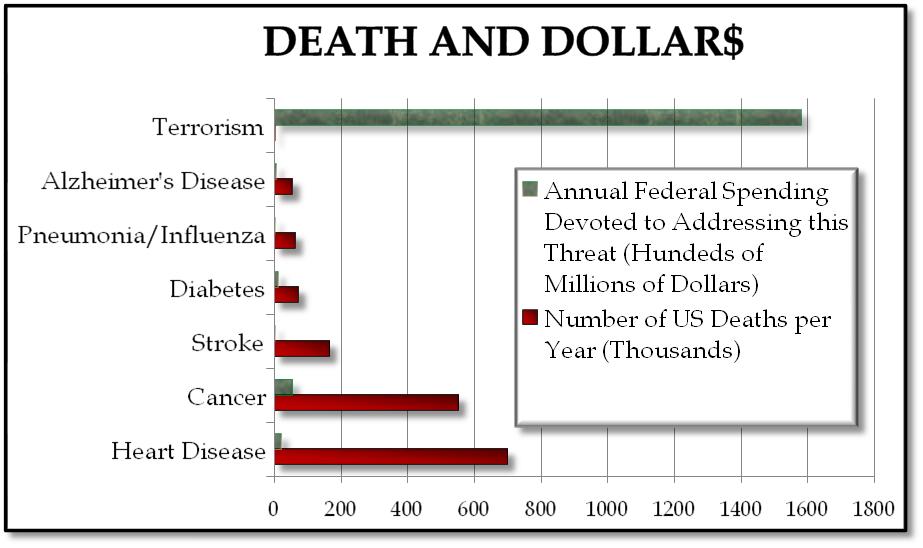
Why is the government response so disproportionate to the threat?
EVOLUTION
Evolutionary psychology may be able to explain this phenomenon. The human brain has been around for 200,000 years. More than 99% of that evolution has been characterized by starvation and general scarcity of resources typified the environment in which humans evolved. In this situation, violent acquisition of resources from other groups was often a necessary survival technique. Hence, human brains most hyper-vigilant and aggressive toward human threats (i.e. terrorists) were most likely to survive and propagate these characteristics.
On the other hand, throughout evolutionary history medical science was almost non-existent. Hence, there would be no survival value added by a tendency to focus on more likely health-related causes of death. We just weren’t designed for these times.
ANXIETY FATIGUE
One possible reason is anxiety fatigue. When an individual is subjected to a stimulus for an extended period of time, such as the aroma of a hospital room, the sound of a fan, or the endless nagging of the mother-in-law, their mind eventually just filters it out. Mortality risks such as heart disease and cancer extend farther back in time than even the existence of our current civilization. Our society now more or less accepts these unfortunate facts of life as another cost of doing business. Thus, they’re filtered out of our collective consciousness to some extent. On the other hand, consider the SARS virus scare a few years ago. Despite the absence of a single American fatality, the newness of this airborne illness allowed it to occupy headlines for weeks. Similarly, the Islamic terrorist menace is also a relatively new phenomenon to the US. Maybe threat fatigue for terrorism just hasn’t set in yet.
ECONOMIC CONSEQUENCES
The economic consequences of terrorism would, at first thought, seem like a justification for the level of concern. There was a huge financial cost associated with the 9/11 attacks. Total related insurance claim payments are estimated at $32.5 billion. However, there’s been no definitive proof that the attacks lead to a significant decline in GDP. In fact, a GDP which had been falling due to recession in the quarter prior to 9/11 actually started growing again in the quarter following 9/11.
It’s conventional wisdom that military spending is good for the economy. However, most macroeconomic models show that, in the long term, military spending diverts resources from productive uses, such as consumption and investment. This ultimately slows economic growth and reduces employment. So if one thinks they’re protecting our economy by taking trillions of dollars away from other productive uses to fight the so-called global war on terror, they should consider upgrading their abycuss to a calculator.
NUCLEAR BOMBS
Another seemingly more justifiable reason for a magnified response to terrorism is the potential for a nuclear attack that could result in a far greater number of casualties than the typical terrorist attacks have to date. According to many experts on nuclear proliferation, the possibly insurmountable technical challenges of building or acquiring a thermo-nuclear weapon are enormous. Including the requirement that the weapon be portable, makes the likelihood of acquisition dramatically more remote. However, there is a real threat that highly enriched uranium could be aquired from a former Soviet state and used to make a crude bomb. This is a serious risk and needs to be addressed by either securing or downgrading the 1000 tons of yellowcake remaining within Russia and her neighbors. The government currently spends about a billion dollars on this effort annually. Compare this to the two billion we spend in Iraq every week and one might assume we have a bonobo setting our national security priorities in exchange for bananas.
HUMAN PSYCHOLOGY
Finally, the psychological makeup of our species could also be a contributing factor to this risk amplification. Just look at the plot structure of a work of fiction. The vast majority of conflicts are between a human protagonist and a human antagonist. We seem to maintain an inherent attraction to interpersonal or, on a larger scale, inter-societal conflict. It’s only natural that this affinity translates to our media diet as well. Many studies have shown that the media sets the public policy agenda. So, the point is that interpersonal and societal conflicts like that between Western civilization and Muslim extremists are simply better able to maintain our attention than conflicts between man and complex, abstract medical threats.
In addition, sociologists and psychologists have determined that society amplifies the danger of risks imposed upon them, such as terrorism. Conversely, society finds risks resulting from voluntary behavior, such as car accidents, more acceptable.
Graph Source: http://www.federationofscientists.org
Masking Symptoms vs Fixing Root Causes
Although we spend very little on research to discover root causes and solutions to cure diseases, we 45 times more on feebly trying to mask symptoms with treatments.
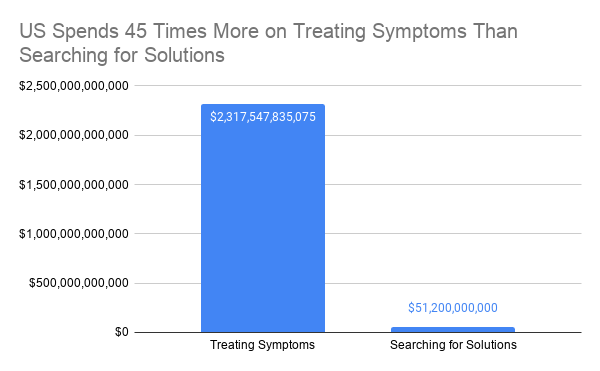
Another way we’re attempting and failing to address symptoms instead of solving the underlying root cause is through the miserable failure that is the War on Drugs. The primary motivation for individuals to take dangerous drugs is a desperate attempt to reduce physical or psychological pain that has not been effectively reduced by the medical establishment. So our solution to this is to spend $51 billion a year imprisoning these people, ruining their lives, ruining their family’s lives, and giving them a prison record making them permanently unemployable. We do all this and still the usage of these drugs and deaths from overdoses has only increased.
So all of these law enforcement resources are being wasted on failing to fight victimless crimes, while 40% of murders, 54.5% of violent crimes, and 82.4% of property crimes go unsolved.

Why not solve the drug problem by spending this $51 billion per year finding solutions to the root psychological and physical pain that motivates drug users instead?
Protect and Promote the General Welfare
The official purpose of government is to promote and protect the general welfare. Unfortunately, in reality, the government very often does the exact opposite. It reduces the general welfare by taxing the general public and funneling their wealth to special interests and corporations large enough to hire lobbyists. So its actual function is to promote and protect the specific welfare of these special interests and only the most wealthy and parasitic fraction of corporations.
The Primary Cause of Disproportionate Spending: Lobbying
For every single member of Congress, there more 23 lobbyists whose full-time job is to badger that single congressperson into giving some corporation or special interest organization money through sweetheart contracts or subsidies.

It’s only rational for special interests to make this investment. For every dollar spent on influencing politics, the nation’s most politically active corporations received $760 from the government. That’s an average 76,000% return on investment compared to the 11% you’ll get from the stock market.
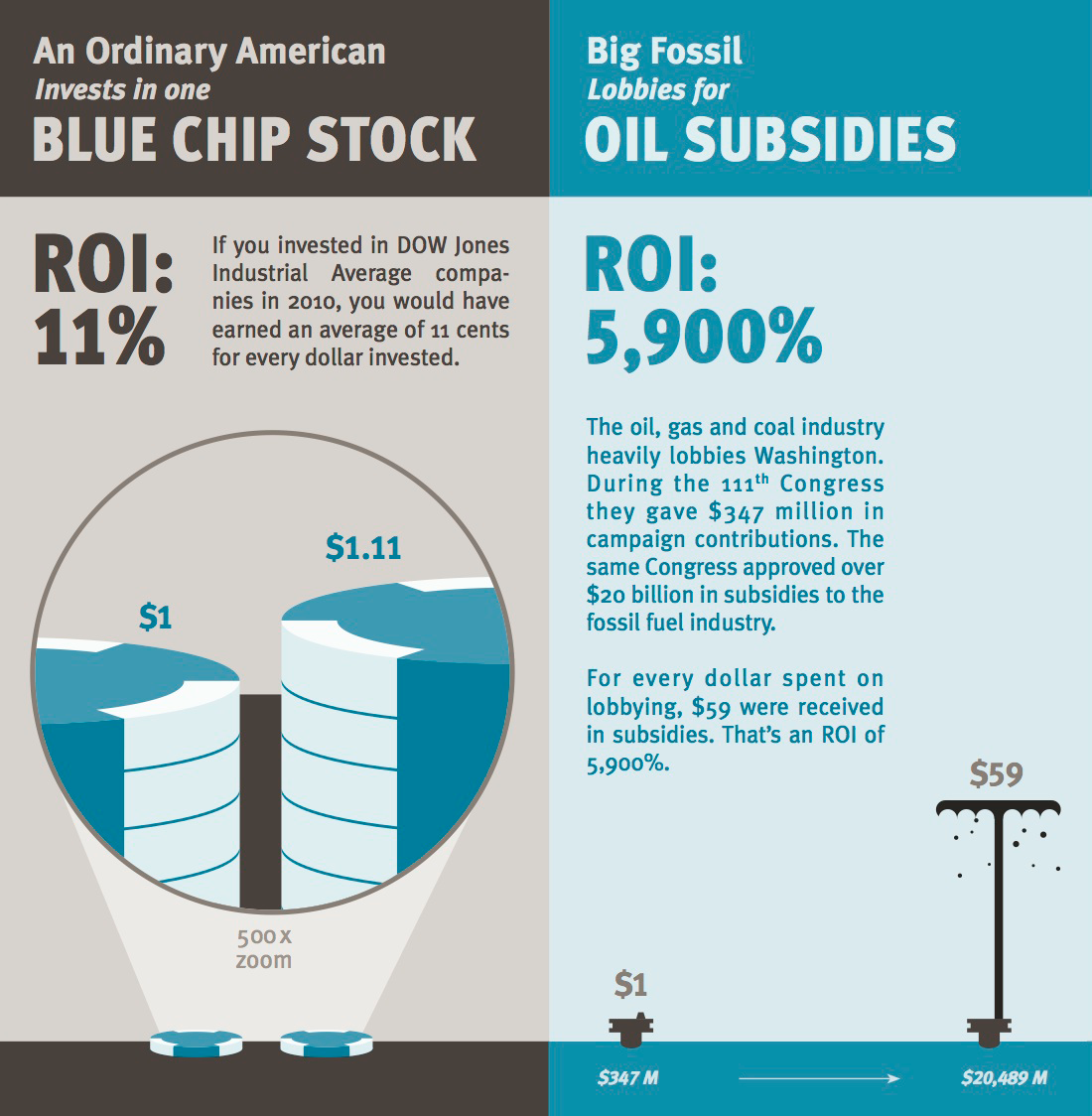
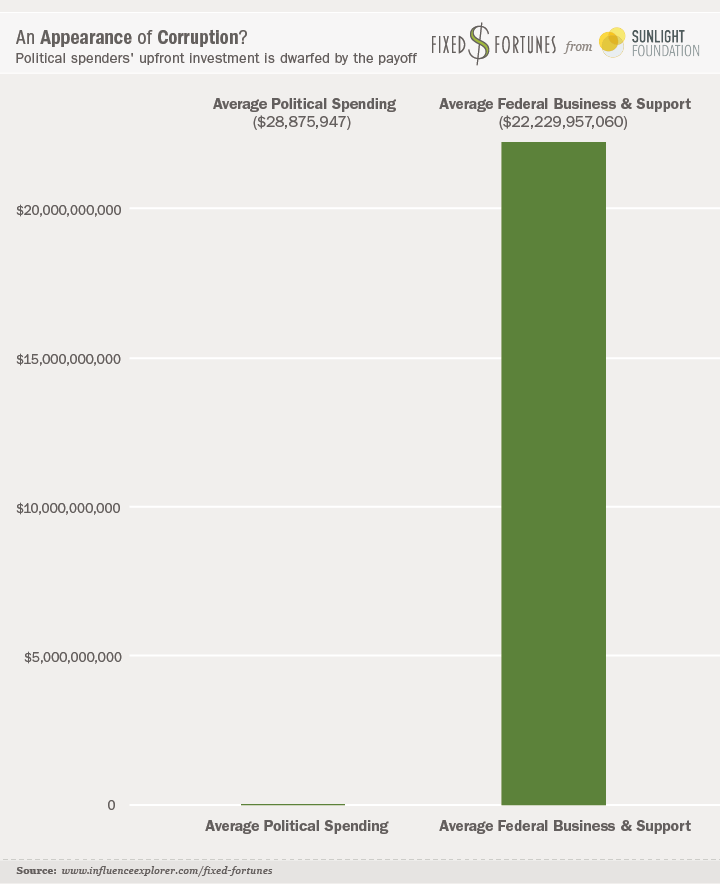
Unrepresentative Democracy
The result of this is nothing less than the complete transfer of power from the citizenry to special interests. In a truly representative democracy, the more public support there is for a policy, the more likely it would be to become law.

However, in reality, public support has almost no influence on what laws are passed. Whether there is 0% or 100% support for a policy, there’s a 30% likelihood that it will become law.

The Solution: A Government Exchange Policy
Buckminster Fuller said that when trying to change something instead of going up against it create something new that makes the problem obsolete. The solution is to have the government issue everyone a receipt with an exchange policy.
Every citizen should have access to a shopping cart showing what their share of public resources will be spent on. They should have the ability to adjust their allocation as they see fit.
It’s important to recognize that our resources are finite so it’s good to have an increase in one are automatically decrease resources in another area. Here’s a crude prototype that you’re welcome to fork and improve:
Federal Budget Allocation Tool Prototype
Do you have any ideas about how to optimize societal resource allocation? Please share them in the comments!

